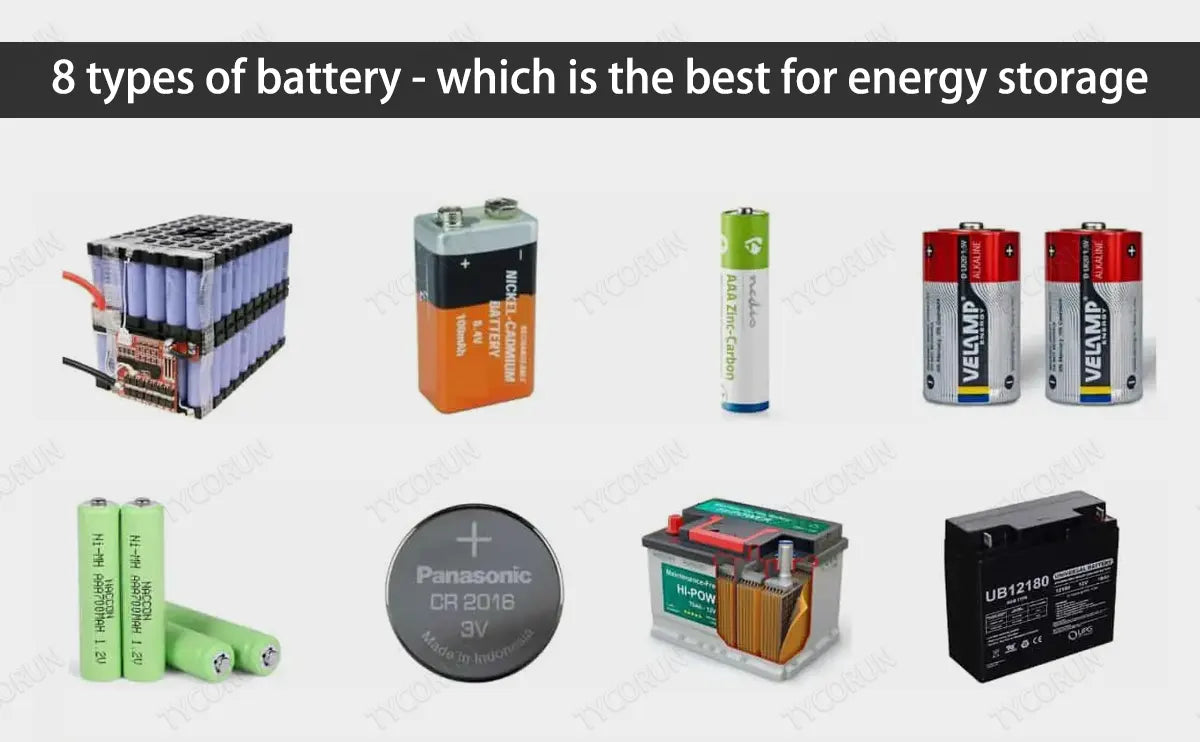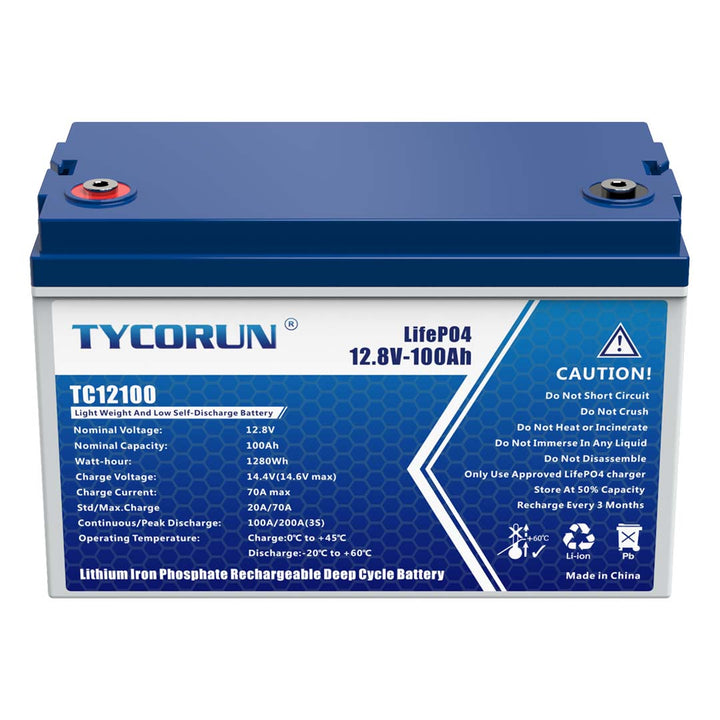
1. Quick introduce: what is energy storage
Broadly speaking, energy storage refers to storing energy in the same form or convert it into another energy form through a medium or device, and then releasing it based on future application needs.
In a narrow sense, energy storage refers to a series of technologies and measures that use chemical or physical methods to store the generated energy and release it when needed.
Next, let’s take a look at the pros and cons of 8 types of battery in energy storage, namely, they are lead-acid battery, Ni-MH battery, lithium-ion battery, supercapacitor, fuel cells, sodium-ion battery, flow battery and lithium-sulfur battery.
2. Comparison of 8 types of battery for energy storage
① Lead-acid battery

Advantages:
- Raw materials are easily available.
- The price is relatively low.
- Good temperature performance, can work in the environment of -40℃-60℃.
- Suitable for float charging, no memory effect.
- Used batteries are easy to recycle and help protect the environment.
Disadvantages:
- Low specific energy, generally 30-40Wh/kg.
- Low service life (300 to 500 times).
- The manufacturing process of this types of battery can easily pollute the environment and must be equipped with three waste treatment equipment.
② Ni-MH battery

Advantages:
- Compared with lead-acid batteries, the energy density of this types of battery has been greatly improved, the weight energy density is 65Wh/kg, and the volume energy density has been improved by 200Wh/L.
- High power density, capable of charging and discharging with larger current.
- Good low temperature discharge characteristics.
- Cycle life (increased to 1000 times).
- Environmentally friendly and pollution-free.
Disadvantages:
- Normal operating temperature range -15-40℃, high temperature performance is poor.
- High self-discharge rate.
- Low working voltage, working voltage range 1.0-1.4V.
- The price is more expensive than lead-acid batteries and nickel chromium batteries, but the performance is worse than lithium-ion batteries.
③ Lithium-ion battery
Click on the picture for product details of Tycorun 12V 100Ah lithium deep cycle battery
Among 8 types of battery, lithium-ion batteries occupy a dominant position, accounting for 92% of the global electrochemical energy storage installed capacity. They are the most important electrochemical energy storage technology at this stage.
Advantages:
- It has high energy density. The single energy density of lithium iron phosphate battery can reach up to 210Wh/kg, and the single energy density of ternary lithium battery has exceeded 300Wh/kg.
- It can charge and discharge quickly with large current, and is suitable for peak shaving and frequency modulation of energy storage power stations.
- The energy conversion efficiency is high, reaching 80-90%.
- Long cycle life. The cycle life of lithium iron phosphate battery reaches more than 4,000 times.
- Good safety performance. Lithium iron phosphate batteries solve the safety hazards of traditional lithium batteries and can ensure high stability without memory effects in the most extreme testing environments.
- Small self-discharge: The self-discharge rate of fully charged Li-ion after one month of storage at room temperature is about 3%, which is much lower than the 25-30% of Ni-Cd and the 30-35% of Ni-MH.
- Environmentally friendly, pollution-free, and does not contain any heavy metal elements harmful to the human body.
Disadvantages:
- Safety needs to be improved. Ternary lithium batteries are unstable when exposed to high temperatures.
- The reserves of this types of battery are limited. The content of lithium resources in the earth's crust only accounts for 0.0065%. Current lithium resources cannot support the vigorous development of future automobile electrification and electrochemical energy storage industries.
④ Supercapacitor

Advantages:
- High power density.
- Short charging time.
Disadvantages:
- The energy density is low, only 1-10Wh/kg, and the supercapacitor's cruising range is too short to be used as a mainstream power source.
⑤ Fuel cells

Advantages:
- High specific energy and high monomer capacity.
- High power density, capable of charging and discharging with large current.
- Environmentally friendly and pollution-free.
Disadvantages:
- The system is complex and the technology maturity is poor of the types of battery.
- The construction of hydrogen supply system lags behind.
- It has high requirements on sulfur dioxide in the air. Due to serious air pollution,the life of fuel cell vehicleis short.
⑥ Sodium-ion battery

Advantages:
- High energy density. The energy density of energy storage sodium batteries can reach 200Wh/kg.
- Long life, it can be charged and discharged many times, and its cycle life can reach more than thousands of times.
- Raw materials are abundant. Energy storage sodium batteries use sodium ions, and sodium is an element widely found on the earth. Compared with rare metals such as lithium, energy storage sodium batteries have more abundant material resources. In addition, sodium batteries do not contain heavy metals that pollute the environment, so they have less impact on the environment.
- Low cost, because sodium is relatively cheap and sodium resources are abundant, which helps reduce the overall cost of the battery.
Disadvantages:
- This types of battery is large in size. Because the size of sodium ions is larger, so a larger electrode surface area is required to accommodate more ions. This results in a larger volume of sodium energy storage batteries and certain space limitations.
- Energy density is lower than lithium-ion batteries.
- The stability needs to be improved, especially in complex environments such as high temperature or high pressure, sodium ions are prone to unstable reactions, which may lead to safety issues such as battery combustion or explosion. This is a problem that needs to be further solved in energy storage of this types of battery.
- Limited commercial applications. There are relatively few commercial applications of energy storage sodium batteries. They are currently mainly used in some large energy storage systems and energy storage needs in specific scenarios, such as solar and wind energy storage. However, their application in small electronic products and automobiles has yet to be further developed.
⑦ Flow battery

Advantages:
- Safe and capable of deep discharge;
- Large scale, no limit on storage tank size;
- Has a high charge and discharge rate;
- Long life and high reliability;
- No emissions and low noise;
- Fast charging and discharging switching, only 0.02 seconds;
- Site selection is not subject to geographical restrictions.
Disadvantages:
- Cross-contamination of positive and negative electrolytes;
- Some require expensive ion exchange membranes;
- The two solutions have large volumes and low specific energy;
- The energy conversion efficiency is not high in this types of battery .
⑧ Lithium-sulfur battery

Advantages:
- High energy density, the theoretical energy density can reach 2600Wh/kg;
- Low raw material cost;
- Low energy consumption;
- Low toxicity.
Disadvantages:
- The solid reaction product lithium oxide (Li2O) will accumulate on the positive electrode, blocking the contact between the electrolyte and the air, causing the discharge to stop. The technology of this types of battery is difficult and without major breakthroughs, it may take another 10 years to achieve commercial use.
3. Conclusion
With the advancement of global low-carbon transformation, electrochemical battery energy storage technology will still be dominated by lithium-ion batteries in the next few years. Lithium iron phosphate batteries have excellent safety, long cycle life, low cost and are environmentally friendly. They are currently the best choice for 8 types of battery in energy storage.
Related articles: Lithium ion battery industry, charging 24V lithium battery, 14500 battery vs 18650
















